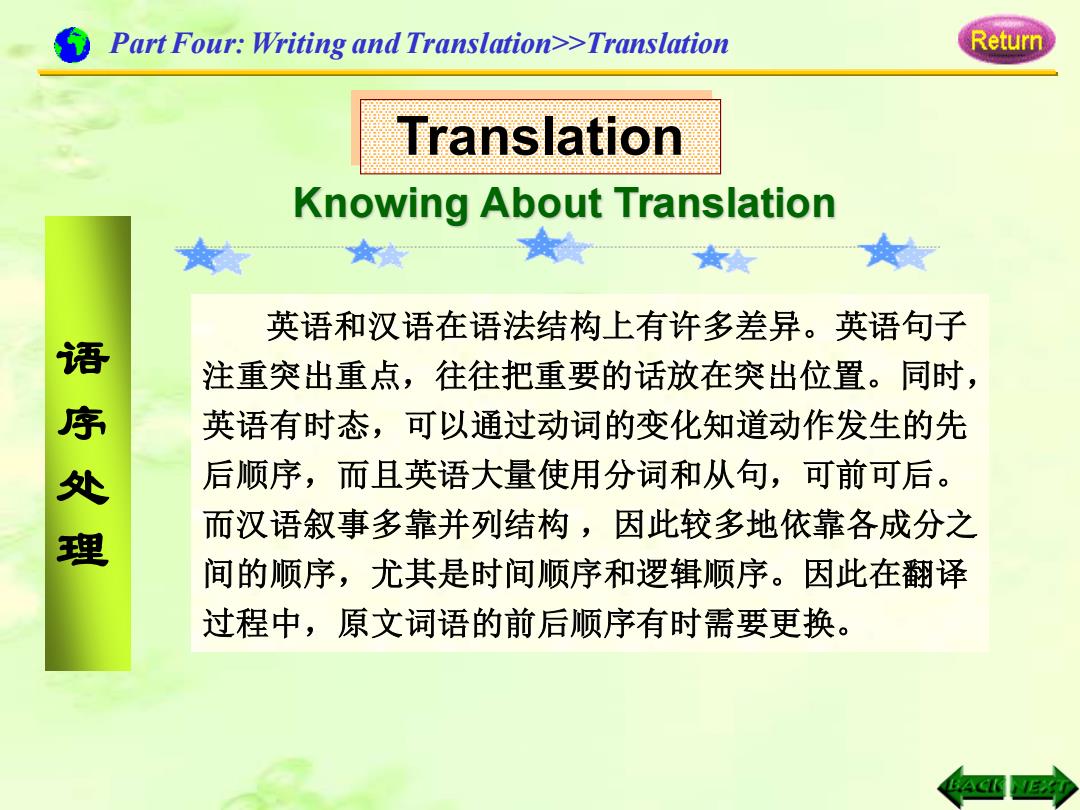
Part Four:Writing and Translation>>Translation Return Translation Knowing About Translation ★★ ★ ★★ 英语和汉语在语法结构上有许多差异。英语句子 语序处理 注重突出重点,往往把重要的话放在突出位置。同时, 英语有时态,可以通过动词的变化知道动作发生的先 后顺序,而且英语大量使用分词和从句,可前可后。 而汉语叙事多靠并列结构,因此较多地依靠各成分之 间的顺序,尤其是时间顺序和逻辑顺序。因此在翻译 过程中,原文词语的前后顺序有时需要更换
英语和汉语在语法结构上有许多差异。英语句子 注重突出重点,往往把重要的话放在突出位置。同时, 英语有时态,可以通过动词的变化知道动作发生的先 后顺序,而且英语大量使用分词和从句,可前可后。 而汉语叙事多靠并列结构 ,因此较多地依靠各成分之 间的顺序,尤其是时间顺序和逻辑顺序。因此在翻译 过程中,原文词语的前后顺序有时需要更换。 Part Four: Writing and Translation>>Translation Knowing About Translation 语 序 处 理 Translation
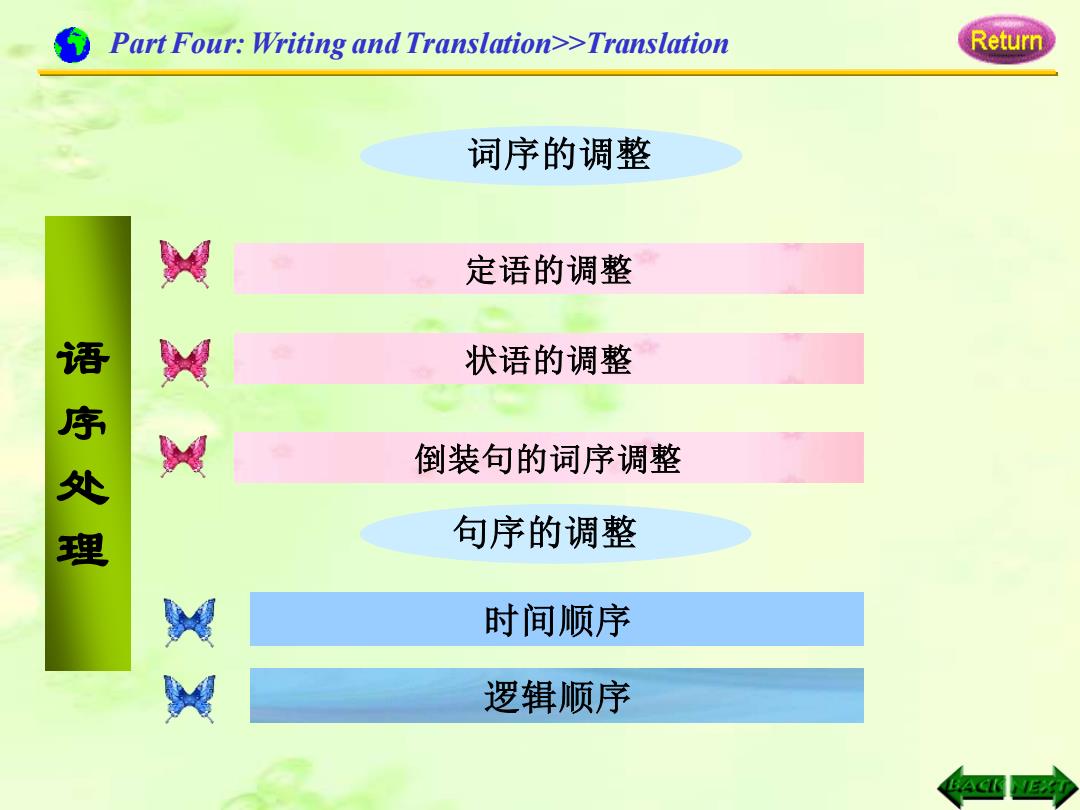
Part Four:Writing and Translation>>Translation Return 词序的调整 定语的调整 状语的调整 语序处理 倒装句的词序调整 句序的调整 时间顺序 逻辑顺序
定语的调整 状语的调整 句序的调整 词序的调整 时间顺序 逻辑顺序 Part Four: Writing and Translation>>Translation 语 序 处 理 倒装句的词序调整

Part Four:Writing and Translation>>Translation Return 词序的调整 A.定语的调整 根据汉语与英语修饰语位置的不同(汉语中修饰语大多在所修 饰名词前,而在英语中相当多的修饰语需作为后置定语),在做英 译汉翻译时应根据汉语习惯,作必要的调整。 1)For example,a brand-loyalty study done by Seventeen magazine found that at least 30 percent of adult women were using the same brands they first chose as teenagers. 比如,《土七岁》杂志做了一个有关品牌忠诚度的研究,发 现至少有百分之三十的成年妇女还在用她们少女时代最初选用 的牌子。(过去分词短语done by Seventeen magazine 作后置定语在翻译时被放在所修饰的名词之前。) To be continued
词序的调整 A. 定语的调整 根据汉语与英语修饰语位置的不同(汉语中修饰语大多在所修 饰名词前,而在英语中相当多的修饰语需作为后置定语),在做英 译汉翻译时应根据汉语习惯,作必要的调整。 1) For example, a brand-loyalty study done by Seventeen magazine found that at least 30 percent of adult women were using the same brands they first chose as teenagers. 比如,《十七岁》杂志做了一个有关品牌忠诚度的研究,发 现至少有百分之三十的成年妇女还在用她们少女时代最初选用 的牌子。(过去分词短语done by Seventeen magazine 作后置定语在翻译时被放在所修饰的名词之前。) To be continued Part Four: Writing and Translation>>Translation
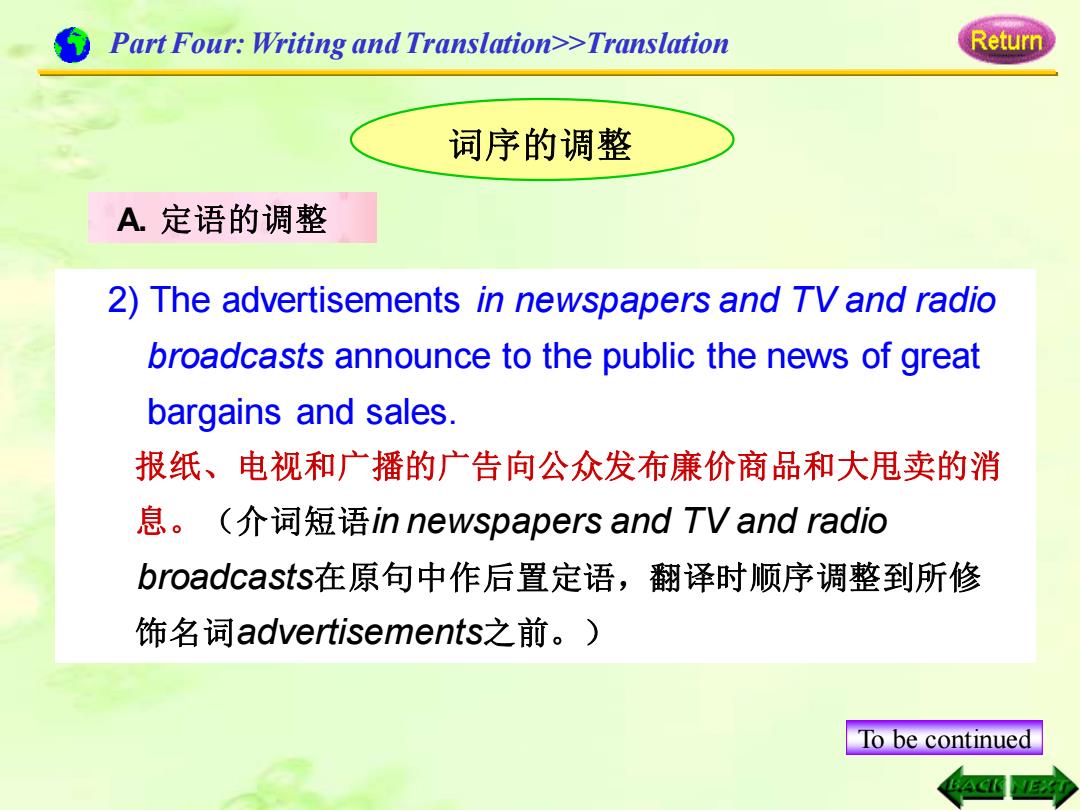
Part Four:Writing and Translation>>Translation Return 词序的调整 A.定语的调整 2)The advertisements in newspapers and TV and radio broadcasts announce to the public the news of great bargains and sales. 报纸、电视和广播的广告向公众发布廉价商品和大甩卖的消 息。(介词短语in newspapers and TV and radio broadcasts在原句中作后置定语,翻译时顺序调整到所修 饰名词advertisements之前。) To be continued
词序的调整 A. 定语的调整 2) The advertisements in newspapers and TV and radio broadcasts announce to the public the news of great bargains and sales. 报纸、电视和广播的广告向公众发布廉价商品和大甩卖的消 息。(介词短语in newspapers and TV and radio broadcasts在原句中作后置定语,翻译时顺序调整到所修 饰名词advertisements之前。) To be continued Part Four: Writing and Translation>>Translation
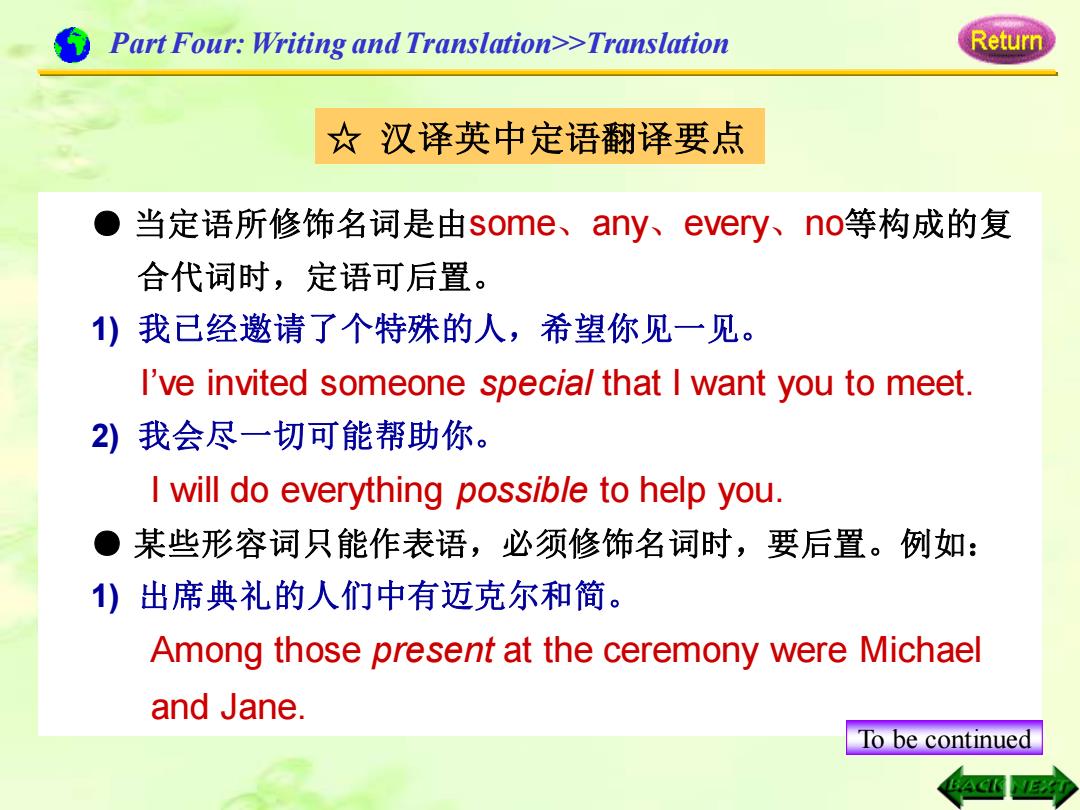
Part Four:Writing and Translation>>Translation Return ☆汉译英中定语翻译要点 当定语所修饰名词是由some、any、evey、no等构成的复 合代词时,定语可后置。 )我已经邀请了个特殊的人,希望你见一见。 I've invited someone special that I want you to meet. 2)我会尽一切可能帮助你。 I will do everything possible to help you. ●某些形容词只能作表语,必须修饰名词时,要后置。例如: )出席典礼的人们中有迈克尔和简。 Among those present at the ceremony were Michael and Jane. To be continued
● 当定语所修饰名词是由some、any、every、no等构成的复 合代词时,定语可后置。 1) 我已经邀请了个特殊的人,希望你见一见。 I’ve invited someone special that I want you to meet. 2) 我会尽一切可能帮助你。 I will do everything possible to help you. ● 某些形容词只能作表语,必须修饰名词时,要后置。例如: 1) 出席典礼的人们中有迈克尔和简。 Among those present at the ceremony were Michael and Jane. To be continued ☆ 汉译英中定语翻译要点 Part Four: Writing and Translation>>Translation

Part Four:Writing and Translation>>Translation Return ☆汉译英中定语翻译要点 2)它是唯一健在的能做到这点的人。 He's the only man alive who could do it. ● 某些以-ible或-able结尾的形容词用作定语,在与 every、the only或形容词最高级连用来修饰一个名词 时,也常放在所修饰名词之后。例如: )他遭受了能想得出的最可怕的虐待。 He had been subjected to the most terrible abuse imaginable. 2)目前他是唯一可以搞培训的医生。 At present he is the only doctor available for the training program
2) 它是唯一健在的能做到这点的人。 He’s the only man alive who could do it. ● 某些以-ible或-able结尾的形容词用作定语,在与 every、the only 或形容词最高级连用来修饰一个名词 时,也常放在所修饰名词之后。例如: 1) 他遭受了能想得出的最可怕的虐待。 He had been subjected to the most terrible abuse imaginable. 2) 目前他是唯一可以搞培训的医生。 At present he is the only doctor available for the training program. ☆ 汉译英中定语翻译要点 Part Four: Writing and Translation>>Translation
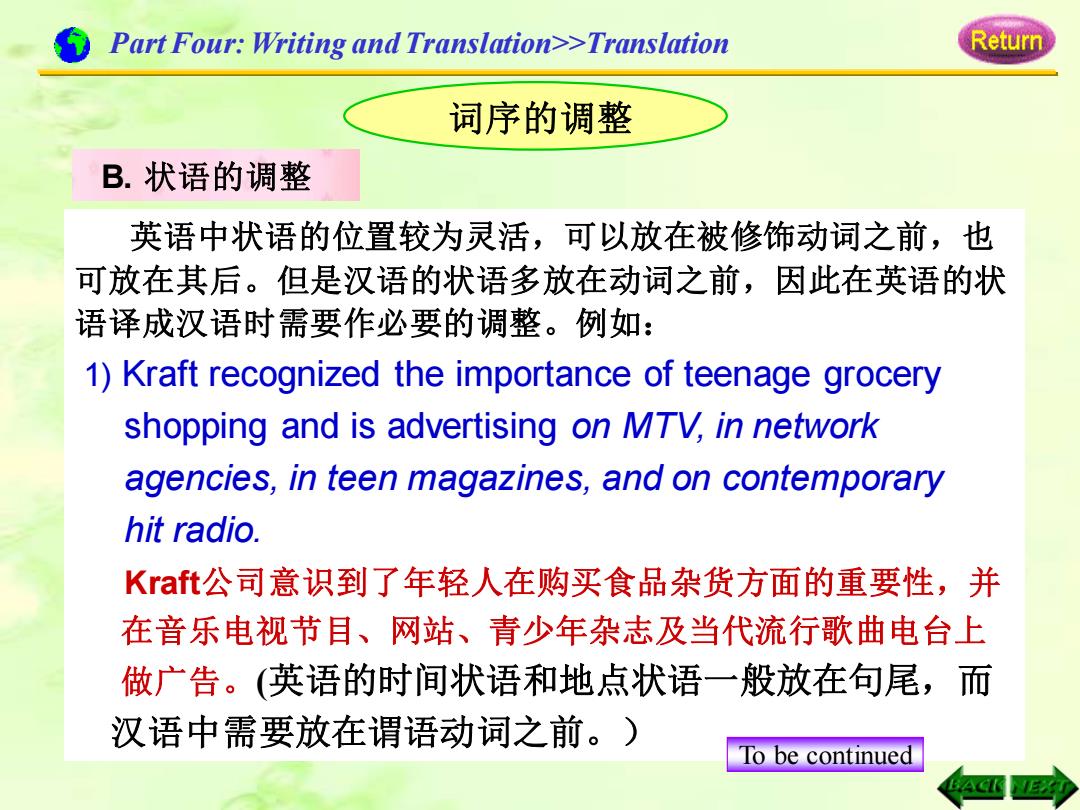
Part Four:Writing and Translation>>Translation Return 词序的调整 B.状语的调整 英语中状语的位置较为灵活,可以放在被修饰动词之前,也 可放在其后。但是汉语的状语多放在动词之前,因此在英语的状 语译成汉语时需要作必要的调整。例如: 1)Kraft recognized the importance of teenage grocery shopping and is advertising on MTV,in network agencies,in teen magazines,and on contemporary hit radio. Kraft公司意识到了年轻人在购买食品杂货方面的重要性,并 在音乐电视节目、网站、青少年杂志及当代流行歌曲电台上 做广告。(英语的时间状语和地点状语一般放在句尾,而 汉语中需要放在谓语动词之前。) To be continued
词序的调整 B. 状语的调整 英语中状语的位置较为灵活,可以放在被修饰动词之前,也 可放在其后。但是汉语的状语多放在动词之前,因此在英语的状 语译成汉语时需要作必要的调整。例如: 1) Kraft recognized the importance of teenage grocery shopping and is advertising on MTV, in network agencies, in teen magazines, and on contemporary hit radio. Kraft公司意识到了年轻人在购买食品杂货方面的重要性,并 在音乐电视节目、网站、青少年杂志及当代流行歌曲电台上 做广告。(英语的时间状语和地点状语一般放在句尾,而 汉语中需要放在谓语动词之前。) To be continued Part Four: Writing and Translation>>Translation

Part Four:Writing and Translation>>Translation Return 词序的调整 B.状语的调整 2) Students went out of the classroom,laughing and talking. 学生们说说笑笑地从教室里出来。 (英语中表示伴随情况的状语在译成汉语时放在谓语 动词之前。) 但也有例外: They,unexpectedly,did not come to the class. 他们没有来上课,这完全是意料之外的事
词序的调整 B. 状语的调整 2) Students went out of the classroom, laughing and talking. 学生们说说笑笑地从教室里出来。 (英语中表示伴随情况的状语在译成汉语时放在谓语 动词之前。) 但也有例外: They, unexpectedly, did not come to the class. 他们没有来上课,这完全是意料之外的事。 Part Four: Writing and Translation>>Translation
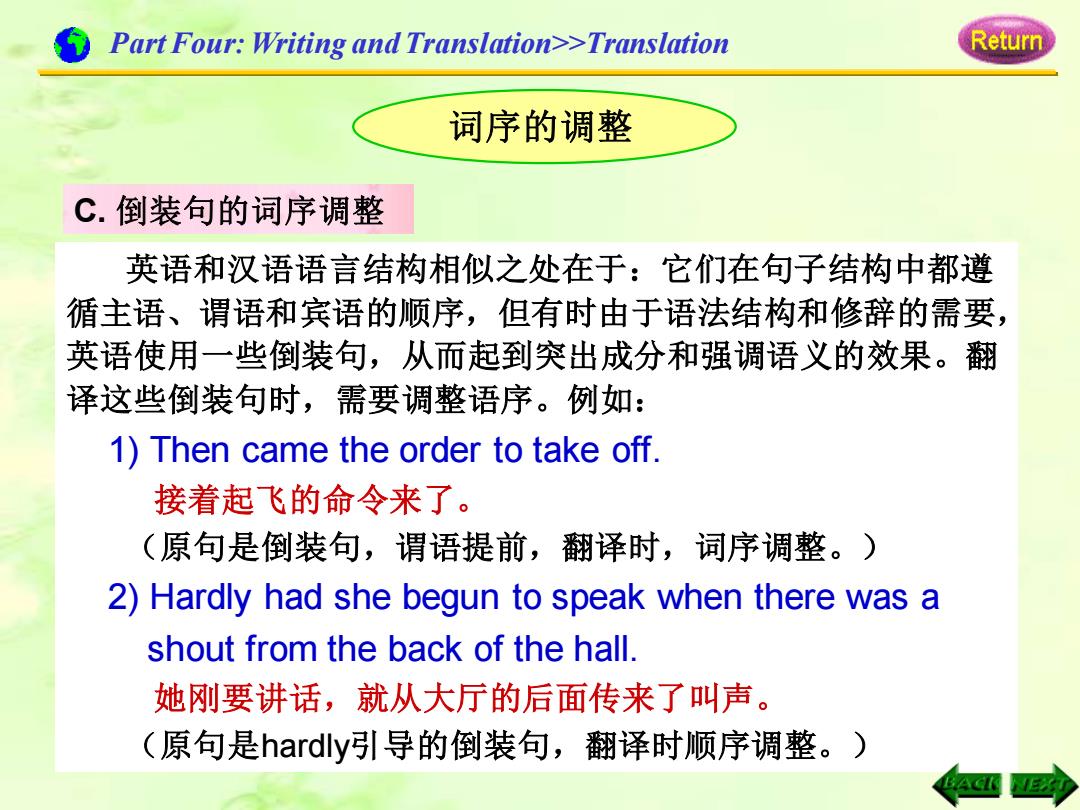
Part Four:Writing and Translation>>Translation Return 词序的调整 C.倒装句的词序调整 英语和汉语语言结构相似之处在于:它们在句子结构中都遵 循主语、谓语和宾语的顺序,但有时由于语法结构和修辞的需要, 英语使用一些倒装句,从而起到突出成分和强调语义的效果。翻 译这些倒装句时,需要调整语序。例如: 1)Then came the order to take off. 接着起飞的命令来了。 (原句是倒装句,谓语提前,翻译时,词序调整。) 2)Hardly had she begun to speak when there was a shout from the back of the hall. 她刚要讲话,就从大厅的后面传来了叫声。 (原句是hardly引导的倒装句,翻译时顺序调整。)
英语和汉语语言结构相似之处在于:它们在句子结构中都遵 循主语、谓语和宾语的顺序,但有时由于语法结构和修辞的需要, 英语使用一些倒装句,从而起到突出成分和强调语义的效果。翻 译这些倒装句时,需要调整语序。例如: 1) Then came the order to take off. 接着起飞的命令来了。 (原句是倒装句,谓语提前,翻译时,词序调整。) 2) Hardly had she begun to speak when there was a shout from the back of the hall. 她刚要讲话,就从大厅的后面传来了叫声。 (原句是hardly引导的倒装句,翻译时顺序调整。) 词序的调整 C. 倒装句的词序调整 Part Four: Writing and Translation>>Translation

Part Four:Writing and Translation>>Translation Return 句序的调整 A.时间顺序 英语复合句可以包含有两个以上的从句,各个从句次序较 为灵活,在翻译时对此要有所调整。例如: 1)He had just come back the day before from the beach (1)where he had a wonderful time after the completion of the construction job(2)he had been engaged in the south (3). 他本来在南方从事一项建筑工程;任务完成后,他就上 海边去度假,在那里玩的很开心,昨天才回来。 (原句不是按时间顺序排列,在翻译时按汉语习惯按时间 顺序排列。)
句序的调整 A. 时间顺序 英语复合句可以包含有两个以上的从句,各个从句次序较 为灵活,在翻译时对此要有所调整。例如: 1) He had just come back the day before from the beach (1) where he had a wonderful time after the completion of the construction job (2) he had been engaged in the south (3). 他本来在南方从事一项建筑工程;任务完成后,他就上 海边去度假,在那里玩的很开心,昨天才回来。 (原句不是按时间顺序排列,在翻译时按汉语习惯按时间 顺序排列。) Part Four: Writing and Translation>>Translation